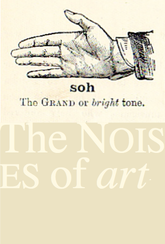THEMES FOR ACADEMIC PRESENTATIONS
Academic papers engaged, but were not limited to, the following indicative topics and themes. The papers, performances, and presentations addressed them from a variety of perspectives, including: visual-art practice; visual-art history, theory, and aesthetics; sound-art practice; sound-art history, theory, and aesthetics; music; performance, TV, theatre, and film studies; pedagogical studies; cognitive science, psychology, and medicine; archivism and museum and gallery studies; and technology:
° sound art and audience reception
° developing a common language for a discourse between sound and visual practice
° ekphrastic responses to and by visual, sound, and text-based arts
° no discipline has a monopoly on itself
° analogues: silence and blankness
° sound and ‘the dematerialization of the art object’
° sound and language
° sound art and ecology
° sound as a sculptural ‘material’
° sound as image/image as sound
° teaching and researching sound art
° the distinctive ways in which visual artists use sound and musician and sound artists use images
° the installation, presentation, and performance of intermedial art works
° the visual dimension of musical performance
° the visuality of musical instruments
° capture and archiving: recording and conserving sound art works, performances, and presentations.
° Duchamp and Cage
° musician-painters, musician-poets, and poet-painters
° sound-art practitioners
° sound art and gender
° sound art and women artists/composers
° image and sound/deafness and blindness
° synaesthesia
° sound art and the body
° the motivations and obstacles to, and the psychology of, intermedial and bi- and tri-medial practices
° the relationship between visual and auditory perception.
° early electronic and electromechanical devices
° sound in performance art and other ‘established’ forms
° image and sound in cinema
° integrations of visual and sound-based practices prior to modernism
° revisiting the ‘sister arts’ in the twenty-first century
° socio-political perspectives on sound art
° sound in art schools since the 1960s
° sounds inspired by images/images inspired by sounds
° the industrial and digital revolutions
° adapting old and inventing new instrumentation
° software programs to facilitate, integrate, and teach sound-art practice
° collage as method and metaphor
° phonography and photography
° returning to feedback
° static sound/kinetic images
° sound and space
° the challenges and limits of learning and adapting to a new discipline
° the relationship between contemporary sound-art practices and other forms of audio-visual fusion,
such as cinema, television and video, theatre, music theatre, and opera
° visual cartography and sound mapping
° when an image or a sound or a text, alone, is not enough.

